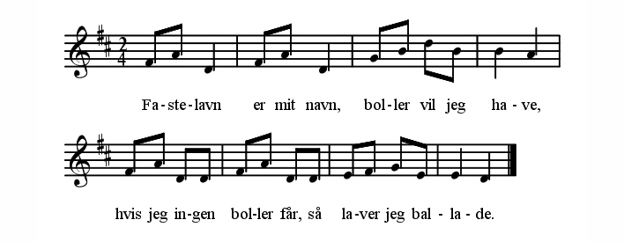Fastelavn is such a sweet and child-centric holiday that its more somber origins have been largely forgotten. Celebrated on the Sunday or Monday before Ash Wednesday (so, this is kind of Scandinavia’s Mardi Gras; make of that what you will), the holiday is based on the Roman Catholic tradition of celebrating the days before Lent.
 Taking place seven weeks prior to Easter, the main tradition associated with the holiday was the placing of a black cat in a barrel and beating the barrel with fastelavnsris (this can be anything from a stick or a club or a bunch of twigs) until it broke apart, releasing the (probably traumatized) cat. This was done to ward off evil.
Taking place seven weeks prior to Easter, the main tradition associated with the holiday was the placing of a black cat in a barrel and beating the barrel with fastelavnsris (this can be anything from a stick or a club or a bunch of twigs) until it broke apart, releasing the (probably traumatized) cat. This was done to ward off evil.
It is believed that the cat-in-barrel tradition was taken from the 18th century Good Friday ritual of child-flogging, to remind children of the pains of Christ on the cross. It should be noted that this was not a widespread tradition at any point in time and is not practiced today (to my knowledge or the knowledge of the internet). Prior to this tradition, it was infertile & young women who were flogged, as the Good Friday flogging ritual seems to have been conflated with a similar fertility ritual.
Fastelavnsris
Apparently, another version of the flogging is that children woke their parents on Fastelavn Sunday by hitting them (or the edge of their bed) with fastelavnsris. When I asked several Danes about this, some looked completely aghast and confused, while others gave a dreamy nostalgic smile.
Luckily, our flogging days are behind us and we now just fill a barrel with candy like a piñata. Children dress up and, at neighborhood and/or school events, hit the barrel with bats until it cracks open and spills the candy. The barrel often still has an image of a cat on it; the person who breaks open the barrel is “Queen of the Cats,” (kattedronning) while the person who breaks the bottom of the barrel is “King of the Cats” (kattekonge). In the past, the title came with a year of tax exemption (uhhh what). The candy is then divided up equally among the children – a lovely departure from my childhood days in the US, when you had to physically fight and/or stab the other children to get treats out of a piñata.
The best part of Fastelavn, for adults, is Fastelavnsboller. They’re sweet choux buns with thick cream in the middle and come in a variety of flavors. In Sweden they’re called Semla or fastlagsbulle. They are delicious.
In addition to the breaking of the barrel, children dress in costume and go “rattling,” (the only way I can translate this word, which in Danish is raslen) where they sing songs door-to-door and beg for candy, buns or money. If they don’t get what they’re after, the threat of mischief comes at the end of the song:


Where to celebrate Fastelavn?
Fastelavn is celebrated in much the same way throughout Denmark and Norway, though small towns may have their own specific traditions.
Danish traditions often include processions and more. On Amager, there’s a horseback procession and traditionally tradespeople offer punch to the participants. The procession continues through carnival week, from Sundby on Saturday, Dragør on Sunday, St Magleby on Monday to Ullerup on Wednesday. Royal Family members have often also more recently attended the carnival riding in Store Magleby.
In Vanløse, there’s a massive procession throughout the weekend. Towns like Veksø and Bornholm have their own dedicated carnival clubs who organize the yearly festivities.
Æro, one of the Danish Baltic Sea islands, goes all out: children awaken the island at 5 am, singing traditional songs. Adults wear masks all day, and when you enter someone’s home they have three guesses as to who you are. Before leaving (or when your hosts guesses), you drop your mask and enjoy a drink together. Finally at midnight, all the masks are dropped.
In the Icelandic town of Ísafjörður, the holiday is called Maskadagur. In Sweden, it is called Fettisdagen and is observed on the Tuesday prior to Ash Wednesday.

So there’s your Fastelavn history; make sure you grab a fastelavnsbolle and a cup of coffee before the season is up!
Do you celebrate Fastelavn differently? Do you celebrate it outside of Scandinavia? Tell us about it in the comments!
This article was first published in February, 2015.

